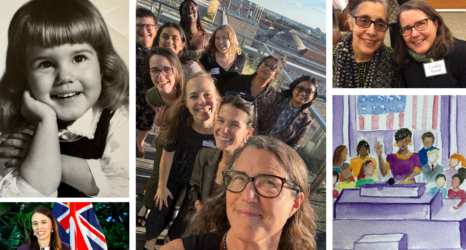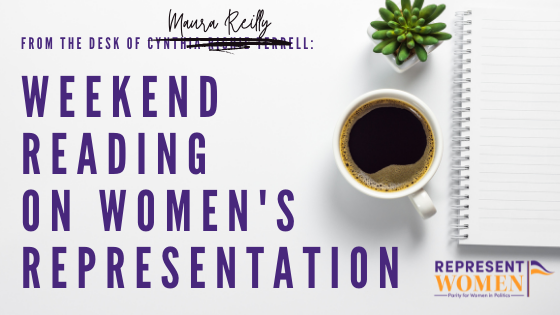
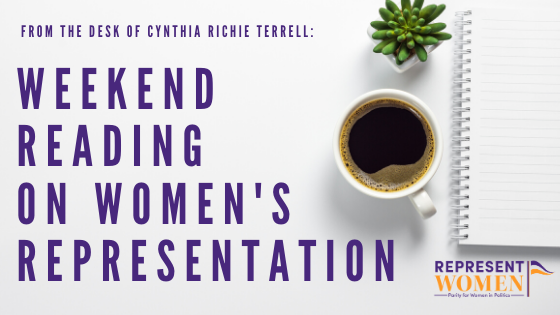
Weekend Reading on Women’s Representation is a compilation of stories about women’s representation in politics, on boards, in sports and entertainment, in judicial offices and in the private sector in the U.S. and around the world—with a little gardening and goodwill mixed in for refreshment!

The New York City mayoral primary is quickly approaching on June 22; it is the first citywide election to use ranked-choice voting since it was re-adopted in 2019. This week Vogue interviewed the three women candidates about their platforms and running for an office never held by a woman.
New York City has had 108 mayors. Not a single one of them has been a woman—but that could change in 2021 as three female candidates emerge as strong, competitive contenders in the June 22 Democratic primary.
“We’re not asking, ‘Can these guys actually do this job?’” says candidate Kathryn Garcia. “But we do ask ‘Can a woman win?’ Every time you have the conversation of viability and not ability, it makes it so people think, ‘Oh, she can’t possibly win.’ Shouldn’t we actually be asking ourselves who’s going to be a good mayor?”
Here, Vogue meets Garcia, Dianne Morales, and Maya Wiley and hears why—in the midst of a pandemic, economic crisis, and racial reckoning—this is the year for New York City to finally elect a female mayor.

In the Vogue article above, mayoral candidate Kathryn Garcia concisely pointed out the double standard women candidates face when running for elected office. The likability trope women face when running continues to call into question women candidates supposed ‘electability’ often ignoring their qualifications for the role. Former RepresentWomen intern Anna had a great piece on the “likability” trope and how ranked-choice voting could help to mitigate this barrier published in Ms. this week:
With a ranked-choice Voting (RCV) system, candidates campaign not only for first-choice votes, but also second- and third-choice votes, which encourages coalition-building rather than partisan and personal attacks. It forces the focus to be on candidates’ policy agendas and how they plan to address issues facing voters, rather than attacking and focusing on personal characteristics. This, in turn, forces the media and other consumption platforms to do the same. Because of how RCV systems are designed, candidates and voters alike have found ranked-choice elections to incentivize positive and issue-focused campaigns.
Research has shown time and again that women being less electable is a myth. Yet women candidates are forced to run a second race—trying to convince donors and electors that they are capable of winning.
Ranked-choice voting will help to correct many of the systemic stumbling blocks women candidates face in the U.S. including the incumbency advantage and the financial disadvantage, but it also has the potential to turn the likability trope on its head. We need to improve our systems and work as a society to focus less on women’s “likability” and “electability” and rather evaluate whose policy and political ambitions will better serve our country.
I’m sure you all know there are currently only EIGHT women governors. The number remains low despite the increasing number of women legislators at the state and national levels in part because of the absurd amount of money it takes to win as a woman, even if you are a qualified woman candidate.
On a more positive note, the Democratic Governors Association (DGA) has taken steps to increase the number of women governors with the Women Governors Fund, a fund dedicated to women gubernatorial candidates. Co-chaired by Governors Kate Brown (OR) and Michelle Lujin Grisham (NM), the fund aims to raise $5 million in 2021 to help lower the financial barrier women face when running. Learn more about this great intentional action from The 19th:
Their commitment comes ahead of 36 governor’s races in 2022 — 20 seats currently held by Republicans and 16 seats currently held by Democrats.
“We have an obligation to remove key barriers, and certainly one of those is resources,” said Lujan Grisham, who is chair of the DGA. “So if we know that we’re not getting to the voters, that we’re not introducing them to these incredible women who by all accounts have incredible outcomes as executives, then we need to make sure that there’s a direct, finance-resource mechanism that is available to these up-and-coming statewide candidates.”
The outsized role of fundraising in governor’s races has come into focus in recent years. In a 2019 report, the Barbara Lee Family Foundation noted that “women candidates still report being excluded from financial circles that include the wealthiest and best-connected donors.”
CAWP’s report, in partnership with the National Institute on Money in Politics, concluded that Democratic women candidates are less likely than Democratic men to self-finance their campaigns. Thirteen percent of Democratic women’s total receipts are a result of self-financing, compared with 19 percent for Democratic men. (The proportion of funds from self-financing is similar for Republican women and men — about 20 percent.) The CAWP report noted a racial gap in fundraising: Women of color are less likely to rely on self-financing than White women.
Women gubernatorial candidates are also generally more reliant in their primaries on small contributions compared to men.
Another key dynamic to the dearth of women governors: Incumbent governors who seek reelection rarely lose their primaries. To date, 20 states have never elected a woman governor.

The Irish Examiner talked to Irish political parties about how they will tackle upholding the new 40 percent gender quota in their next election cycle. A 30 percent gender quota was first used during the 2016 election cycle, with the intention of raising it to 40 percent after two election cycles.
In the past, more established parties like the Fine Gael and Fianna Fáil have struggled to meet the 30 percent quota forcing them to add women candidates to party lists at the last minute and often leading to in-fighting. The article also discusses the process of getting gender quotas implemented in the first place, responding to commonly held misconceptions that women who fill these quotas lack the merit needed to win, in response former minister Kathleen Lynch has said:
“I suppose the people that were listened to most in that debate were women,” she says. “Men actually didn’t even need to make the counter-argument.
“In fairness, men couldn’t make the counter-argument, but very powerful women were making the counter-argument, stating: ‘I want to be elected on merit.’
It was crazy stuff and I used to keep asking them: ‘Do you actually believe there are more meritorious men in the world than women?’
She said the 2009 ‘Women’s Participation in Politics’ report authored by Ivana Bacik for the Joint Oireachtas Committee on Justice was a key moment.This report found that the obstacles to women’s equal participation in politics can be described as ‘the five Cs’ — cash, childcare, confidence, culture and candidate selection procedures.
Ms Lynch now believes that we need to go further than the current system of gender quotas for candidate selection and set aside female-only Dáil seats.
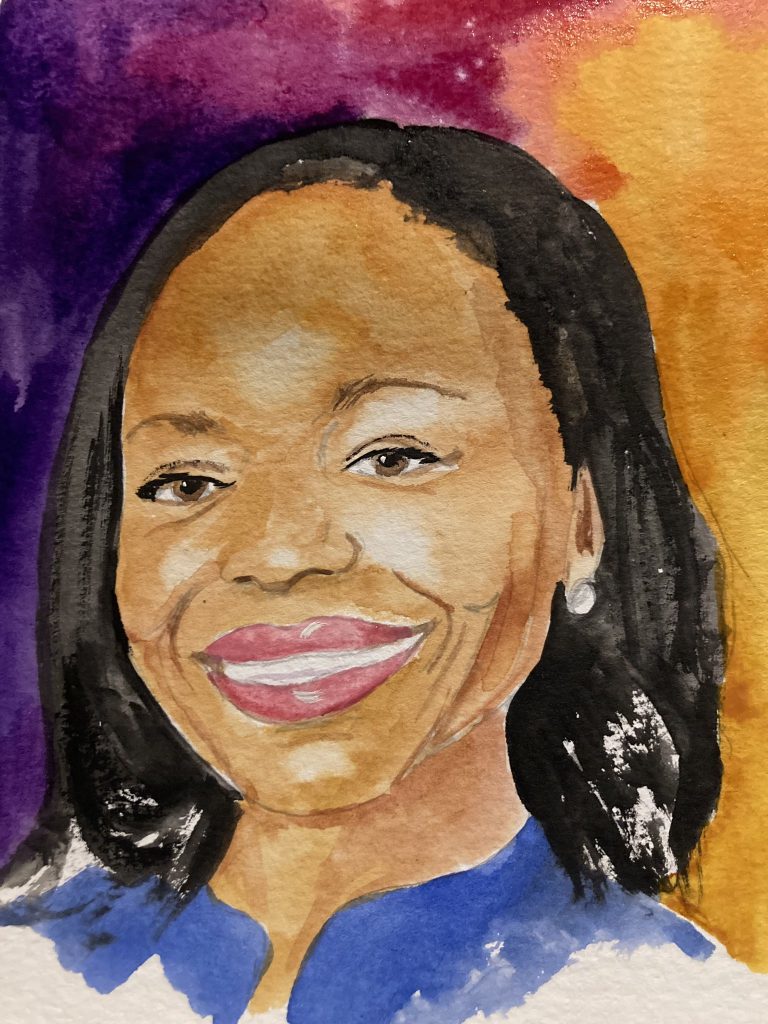
This week several women made history in their respective fields, including Kristen Clarke who was confirmed as the first woman and first Black woman to lead the Justice Department’s Civil Rights division. Her confirmation comes nearly 28 years to the day after Lani Guinier’s nomination for the same role was withdrawn by former President Clinton.
Democrats confirmed Kristen Clarke on Tuesday as the first Black woman to lead the Justice Department’s Civil Rights division, a historic step that came on the anniversary of George Floyd’s killing — and after a vitriolic campaign by Republicans over her stance on policing.
The vote was 51-48 with Sen. Susan Collins as the only Republican voting for her confirmation. Clarke’s confirmation breaks barriers in a department that was established in 1957.
She was ceremonially sworn in by Vice President Kamala Harris at the Justice Department on Tuesday evening. Harris spokesperson Symone Sanders praised Clarke as “a timeless champion of equal justice” in a statement before the ceremony.
“This is a historic moment because for the first time since its creation, following the enactment of the Civil Rights Act of 1957, the confirmed Assistant Attorney General for Civil Rights will be a woman, and will be a black woman, and that is Kristen Clarke,” Sanders said.
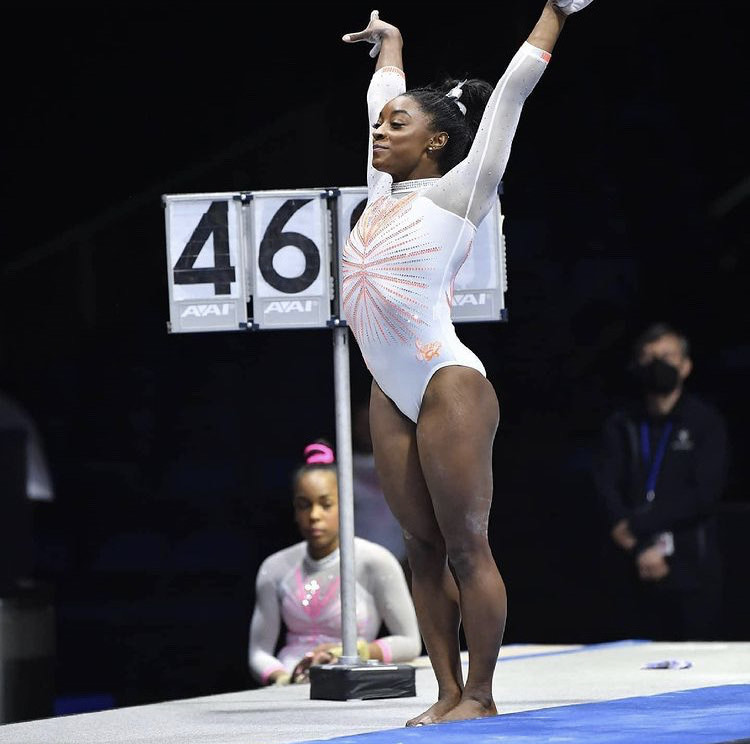
In the sports world, Simone Biles became the first woman to land a Yurchenko double pike vault. The feat may mean little to those without a gymnastics background, so for some context, from vault to floor Biles flipped three times from vault to floor, twice in a piked position. Biles, who wore a leotard emblazoned with a rhinestone goat, representing her Greatest Of All Time (GOAT) status, is already the most decorated gymnast in history, a record which she is almost certain to break in the upcoming Olympic games.
It was the final night of the 2021 U.S. Classic on Saturday when Simone Biles attempted a move considered so dangerous in the gymnastics world that no other woman in the sport — not even the woman it’s named after — has tried it in a competition. Being the record-breaking athlete that she is, however, Biles changed that: She is now the first woman in history to execute the Yurchenko double pike.
Pioneered in part by former Russian gymnast Natalia Yurchenko, who first introduced the roundoff back handspring onto the vaulting table, the Yurchenko double pike is considered an untouchable move in the gymnastics world because of how dangerous the execution and landing can be. It consists of a running start to the vaulting table; a roundoff back handspring; two flips mid-air in a pike position, where the body is folded and the legs are fully extended, and a clean landing on both feet.
On another note, in the same competition, Chellsie Memmel competed for the first time since coming out of retirement. The 32 year old, mom of two made a comeback after nearly nine years of retirement from the sport. Previously Memmel was on the 2008 Olympic team that won silver in Beijing, she competed on bars for the team competition despite a severe ankle injury. In case it isn’t clear from the long section on gymnastics in the middle of a women in politics reading round-up, I’m a big fan even though my own skills would be considered laughable.
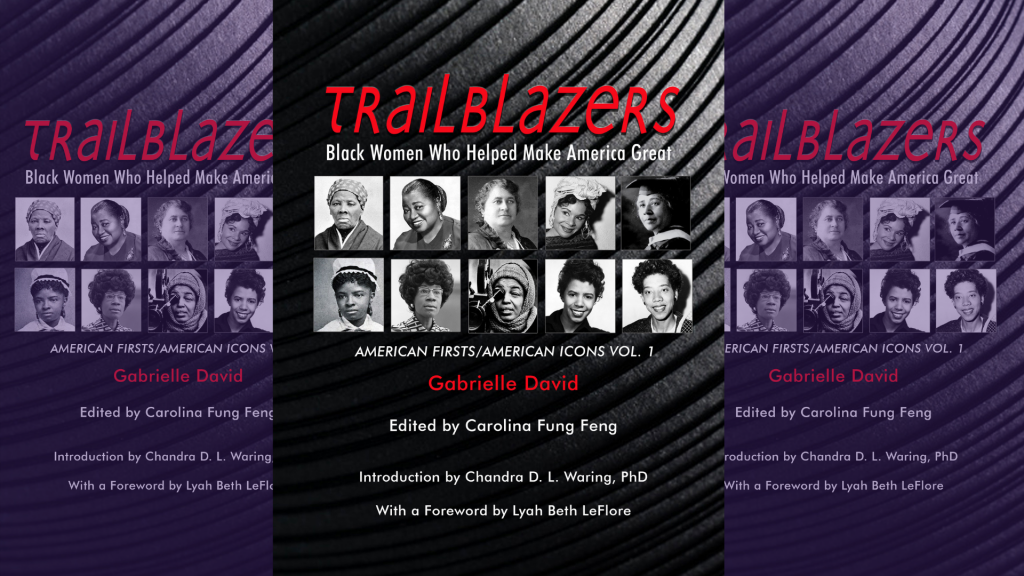
Despite the many achievements and contributions women have made throughout history, women and women of color in particular are often left out of the history books. In recent years some authors have been trying to correct this by writing anthologies and history books about women’s contributions. One such is TRAILBLAZERS: Black Women Who Helped Make America Great, this week RepresentWomen talked with the author, Gabrielle David, about the her inspiration for the book and what she hopes readers will get from the book, read the full interview here:
Despite historic achievements, accomplishments and advancements Black women have made throughout U.S. history, their stories are often overlooked and left out of the history books. A problem that 2Leaf Press, “a small press with big ideas,” is hoping to help correct with their latest book TRAILBLAZERS: Black Women Who Helped Make America Great.
The first of six volumes, TRAILBLAZERS: American Firsts/American Icons, features sixty-five activists, dancers and athletes who have blazed trails, broken records, and made history from the founding of the country to present day.
Q: Was there anything that surprised you when you started researching and writing this book?
Lots.
I consider myself a storyteller, I’m not a scholar, I don’t have a PhD. I grew up in a household that was multicultural by nature. I’m Black but my mother taught us it was important to learn about other people’s cultures and about our history; so I have always been an avid reader. So a lot of people who know me will say “oh, she knows a lot,” and doing the research on this I discovered so many different things that I hadn’t realized had happened or had existed.
And putting the story together of Black women activists and what they went through, you know they weren’t allowed to be up front, they were left in the background so that people like Martin Luther King Jr. or Malcolm X and all these other people could be in the foreground. Because of the times that they lived in, that’s what women did, women stayed in the kitchen. But in reality, in any of the movements that you see in this country, women have always played a major role. Not just the cooking and taking care of the kids, they played a role in organizing, getting the word out, making sure that everything was in place, connecting to other organizations. This is the stuff that women have done for centuries; but men have gotten all the credit for and so it is for the Civil Rights movement. A lot of Black women did great stuff, Ella Baker, Rosa Parks and so on.
They were relegated to behind the scenes, when you look at the 1963 March on Washington, the women weren’t allowed to speak, the women weren’t allowed to march at the front with the men, and the women weren’t allowed to go to the White House to meet with Kennedy. But it was the women like Dorothy Height, like Pauli Murray, all these women they were responsible for helping to organize this event, to make it happen.





